Base class for all NNP applications. More...
#include <Mode.h>
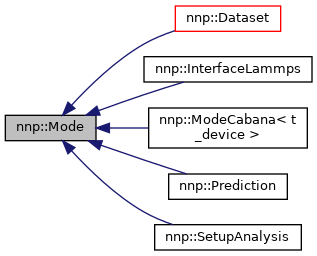
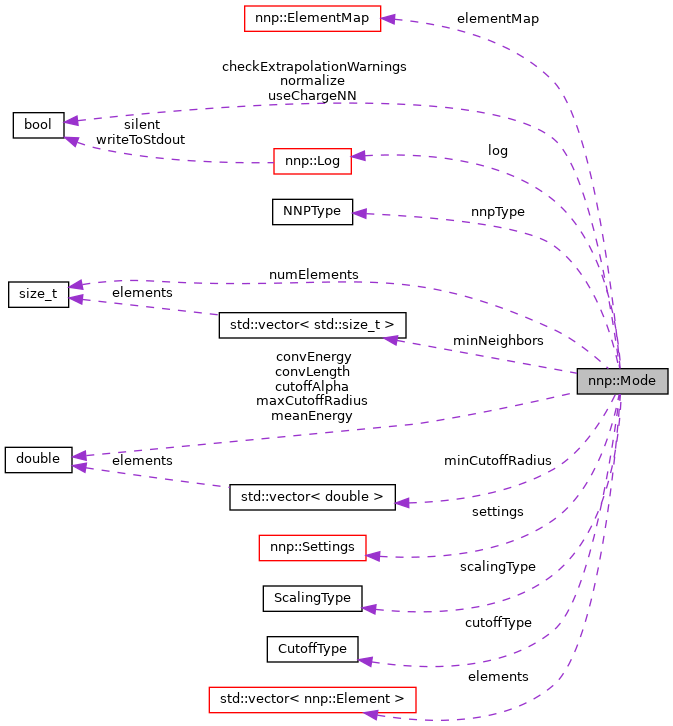
Classes | |
| struct | NNSetup |
| Setup data for one neural network. More... | |
Public Types | |
| enum class | NNPType { HDNNP_2G = 2 , HDNNP_4G = 4 , HDNNP_Q = 10 } |
Public Member Functions | |
| Mode () | |
| void | initialize () |
| Write welcome message with version information. | |
| void | loadSettingsFile (std::string const &fileName="input.nn") |
| Open settings file and load all keywords into memory. | |
| void | setupGeneric (std::string const &nnpDir="", bool skipNormalize=false, bool initialHardness=false) |
| Combine multiple setup routines and provide a basic NNP setup. | |
| void | setupNormalization (bool standalone=true) |
| Set up normalization. | |
| virtual void | setupElementMap () |
| Set up the element map. | |
| virtual void | setupElements () |
| Set up all Element instances. | |
| void | setupCutoff () |
| Set up cutoff function for all symmetry functions. | |
| virtual void | setupSymmetryFunctions () |
| Set up all symmetry functions. | |
| void | setupSymmetryFunctionScalingNone () |
| Set up "empy" symmetry function scaling. | |
| virtual void | setupSymmetryFunctionScaling (std::string const &fileName="scaling.data") |
| Set up symmetry function scaling from file. | |
| virtual void | setupSymmetryFunctionGroups () |
| Set up symmetry function groups. | |
| virtual void | setupSymmetryFunctionCache (bool verbose=false) |
| Set up symmetry function cache. | |
| void | setupSymmetryFunctionMemory (bool verbose=false) |
| Extract required memory dimensions for symmetry function derivatives. | |
| void | setupSymmetryFunctionStatistics (bool collectStatistics, bool collectExtrapolationWarnings, bool writeExtrapolationWarnings, bool stopOnExtrapolationWarnings) |
| Set up symmetry function statistics collection. | |
| void | setupCutoffMatrix () |
| Setup matrix storing all symmetry function cut-offs for each element. | |
| virtual void | setupNeuralNetwork () |
| Set up neural networks for all elements. | |
| virtual void | setupNeuralNetworkWeights (std::map< std::string, std::string > fileNameFormats=std::map< std::string, std::string >()) |
| Set up neural network weights from files with given name format. | |
| virtual void | setupNeuralNetworkWeights (std::string directoryPrefix, std::map< std::string, std::string > fileNameFormats=std::map< std::string, std::string >()) |
| Set up neural network weights from files with given name format. | |
| virtual void | setupElectrostatics (bool initialHardness=false, std::string directoryPrefix="", std::string fileNameFormat="hardness.%03zu.data") |
| Set up electrostatics related stuff (hardness, screening, ...). | |
| void | calculateSymmetryFunctions (Structure &structure, bool const derivatives) |
| Calculate all symmetry functions for all atoms in given structure. | |
| void | calculateSymmetryFunctionGroups (Structure &structure, bool const derivatives) |
| Calculate all symmetry function groups for all atoms in given structure. | |
| void | calculateAtomicNeuralNetworks (Structure &structure, bool const derivatives, std::string id="") |
| Calculate a single atomic neural network for a given atom and nn type. | |
| void | chargeEquilibration (Structure &structure, bool const derivativesElec) |
| Perform global charge equilibration method. | |
| void | calculateEnergy (Structure &structure) const |
| Calculate potential energy for a given structure. | |
| void | calculateCharge (Structure &structure) const |
| Calculate total charge for a given structure. | |
| void | calculateForces (Structure &structure) const |
| Calculate forces for all atoms in given structure. | |
| void | evaluateNNP (Structure &structure, bool useForces=true, bool useDEdG=true) |
| Evaluate neural network potential (includes total energy, optionally forces and in some cases charges. | |
| void | addEnergyOffset (Structure &structure, bool ref=true) |
| Add atomic energy offsets to reference energy. | |
| void | removeEnergyOffset (Structure &structure, bool ref=true) |
| Remove atomic energy offsets from reference energy. | |
| double | getEnergyOffset (Structure const &structure) const |
| Get atomic energy offset for given structure. | |
| double | getEnergyWithOffset (Structure const &structure, bool ref=true) const |
| Add atomic energy offsets and return energy. | |
| double | normalized (std::string const &property, double value) const |
| Apply normalization to given property. | |
| double | normalizedEnergy (Structure const &structure, bool ref=true) const |
| Apply normalization to given energy of structure. | |
| double | physical (std::string const &property, double value) const |
| Undo normalization for a given property. | |
| double | physicalEnergy (Structure const &structure, bool ref=true) const |
| Undo normalization for a given energy of structure. | |
| void | convertToNormalizedUnits (Structure &structure) const |
| Convert one structure to normalized units. | |
| void | convertToPhysicalUnits (Structure &structure) const |
| Convert one structure to physical units. | |
| void | logEwaldCutoffs () |
| Logs Ewald params whenever they change. | |
| std::size_t | getNumExtrapolationWarnings () const |
| Count total number of extrapolation warnings encountered for all elements and symmetry functions. | |
| void | resetExtrapolationWarnings () |
| Erase all extrapolation warnings and reset counters. | |
| NNPType | getNnpType () const |
| Getter for Mode::nnpType. | |
| double | getMeanEnergy () const |
| Getter for Mode::meanEnergy. | |
| double | getConvEnergy () const |
| Getter for Mode::convEnergy. | |
| double | getConvLength () const |
| Getter for Mode::convLength. | |
| double | getConvCharge () const |
| Getter for Mode::convCharge. | |
| double | getEwaldPrecision () const |
| Getter for Mode::ewaldSetup.precision. | |
| double | getEwaldMaxCharge () const |
| Getter for Mode::ewaldSetup.maxCharge. | |
| double | getEwaldMaxSigma () const |
| Getter for Mode::ewaldSetup.maxQsigma. | |
| EWALDTruncMethod | getEwaldTruncationMethod () const |
| Getter for Mode::ewaldSetup.truncMethod. | |
| KSPACESolver | kspaceSolver () const |
| Getter for Mode::kspaceSolver. | |
| double | getMaxCutoffRadius () const |
| Getter for Mode::maxCutoffRadius. | |
| std::size_t | getNumElements () const |
| Getter for Mode::numElements. | |
| ScreeningFunction | getScreeningFunction () const |
| Getter for Mode::screeningFunction. | |
| std::vector< std::size_t > | getNumSymmetryFunctions () const |
| Get number of symmetry functions per element. | |
| bool | useNormalization () const |
| Check if normalization is enabled. | |
| bool | settingsKeywordExists (std::string const &keyword) const |
| Check if keyword was found in settings file. | |
| std::string | settingsGetValue (std::string const &keyword) const |
| Get value for given keyword in Settings instance. | |
| std::vector< std::size_t > | pruneSymmetryFunctionsRange (double threshold) |
| Prune symmetry functions according to their range and write settings file. | |
| std::vector< std::size_t > | pruneSymmetryFunctionsSensitivity (double threshold, std::vector< std::vector< double > > sensitivity) |
| Prune symmetry functions with sensitivity analysis data. | |
| void | writePrunedSettingsFile (std::vector< std::size_t > prune, std::string fileName="output.nn") const |
| Copy settings file but comment out lines provided. | |
| void | writeSettingsFile (std::ofstream *const &file) const |
| Write complete settings file. | |
Public Attributes | |
| ElementMap | elementMap |
| Global element map, populated by setupElementMap(). | |
| Log | log |
| Global log file. | |
Protected Member Functions | |
| void | readNeuralNetworkWeights (std::string const &id, std::string const &fileName) |
| Read in weights for a specific type of neural network. | |
Protected Attributes | |
| NNPType | nnpType |
| bool | normalize |
| bool | checkExtrapolationWarnings |
| std::size_t | numElements |
| std::vector< std::size_t > | minNeighbors |
| std::vector< double > | minCutoffRadius |
| double | maxCutoffRadius |
| double | cutoffAlpha |
| double | meanEnergy |
| double | convEnergy |
| double | convLength |
| double | convCharge |
| double | fourPiEps |
| EwaldSetup | ewaldSetup |
| KspaceGrid | kspaceGrid |
| settings::Settings | settings |
| SymFnc::ScalingType | scalingType |
| CutoffFunction::CutoffType | cutoffType |
| ScreeningFunction | screeningFunction |
| std::vector< Element > | elements |
| std::vector< std::string > | nnk |
| std::map< std::string, NNSetup > | nns |
| std::vector< std::vector< double > > | cutoffs |
| Matrix storing all symmetry function cut-offs for all elements. | |
| ErfcBuf | erfcBuf |
Detailed Description
Base class for all NNP applications.
This top-level class is the anchor point for existing and future applications. It contains functions to set up an existing neural network potential and calculate energies and forces for configurations given as Structure. A minimal setup requires some consecutive functions calls as this minimal example shows:
To load weights and scaling information from files add these lines:
The NNP is now ready! If we load a structure from a data file:
we can finally predict the energy and forces from the neural network potential:
The resulting potential energy is stored in Structure::energy, the forces on individual atoms are located within the Structure::atoms vector in Atom::f.
Member Enumeration Documentation
◆ NNPType
|
strong |
Definition at line 90 of file Mode.h.
Constructor & Destructor Documentation
◆ Mode()
| Mode::Mode | ( | ) |
Definition at line 40 of file Mode.cpp.
References checkExtrapolationWarnings, convCharge, convEnergy, convLength, cutoffAlpha, ewaldSetup, fourPiEps, HDNNP_2G, kspaceGrid, maxCutoffRadius, meanEnergy, nnpType, normalize, and numElements.
Referenced by nnp::Dataset::Dataset(), and nnp::Prediction::Prediction().

Member Function Documentation
◆ initialize()
| void Mode::initialize | ( | ) |
Write welcome message with version information.
Definition at line 56 of file Mode.cpp.
References log, N2P2_GIT_BRANCH, N2P2_GIT_REV, N2P2_GIT_VERSION, and N2P2_VERSION.
Referenced by nnp::InterfaceLammps::initialize(), main(), and nnp::Prediction::setup().
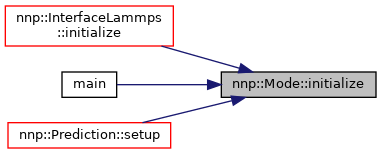
◆ loadSettingsFile()
| void Mode::loadSettingsFile | ( | std::string const & | fileName = "input.nn" | ) |
Open settings file and load all keywords into memory.
- Parameters
-
[in] fileName Settings file name.
Definition at line 162 of file Mode.cpp.
References HDNNP_2G, HDNNP_4G, HDNNP_Q, log, nnpType, settings, and nnp::strpr().
Referenced by nnp::InterfaceLammps::initialize(), main(), and nnp::Prediction::setup().
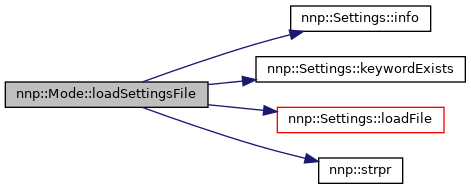
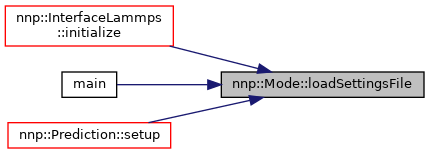
◆ setupGeneric()
| void Mode::setupGeneric | ( | std::string const & | nnpDir = "", |
| bool | skipNormalize = false, | ||
| bool | initialHardness = false ) |
Combine multiple setup routines and provide a basic NNP setup.
- Parameters
-
[in] nnpDir Optional directory where NNP files reside. [in] skipNormalize Whether to skip normalization setup. [in] initialHardness Signalizes to use initial hardness in NN settings.
Sets up elements, symmetry functions, symmetry function groups, neural networks. No symmetry function scaling data is read, no weights are set.
Definition at line 213 of file Mode.cpp.
References HDNNP_4G, nnpType, setupCutoff(), setupCutoffMatrix(), setupElectrostatics(), setupElementMap(), setupElements(), setupNeuralNetwork(), setupNormalization(), setupSymmetryFunctionCache(), setupSymmetryFunctionGroups(), setupSymmetryFunctionMemory(), and setupSymmetryFunctions().
Referenced by nnp::InterfaceLammps::initialize(), main(), and nnp::Prediction::setup().
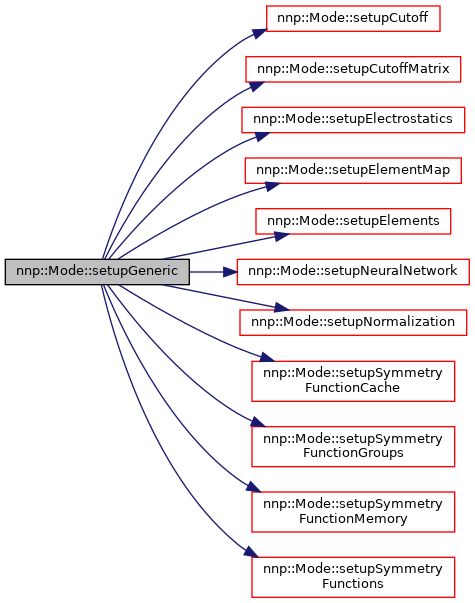
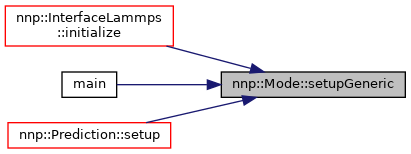
◆ setupNormalization()
| void Mode::setupNormalization | ( | bool | standalone = true | ) |
Set up normalization.
- Parameters
-
[in] standalone Whether to write section header and footer.
If the keywords mean_energy, conv_length and conv_length are present, the provided conversion factors are used to internally use a different unit system.
Definition at line 239 of file Mode.cpp.
References convCharge, convEnergy, convLength, log, meanEnergy, normalize, settings, and nnp::strpr().
Referenced by nnp::Training::dataSetNormalization(), and setupGeneric().


◆ setupElementMap()
|
virtual |
Set up the element map.
Uses keyword elements. This function should follow immediately after settings are loaded via loadSettingsFile().
Reimplemented in nnp::ModeCabana< t_device >.
Definition at line 302 of file Mode.cpp.
References elementMap, log, settings, and nnp::strpr().
Referenced by main(), and setupGeneric().
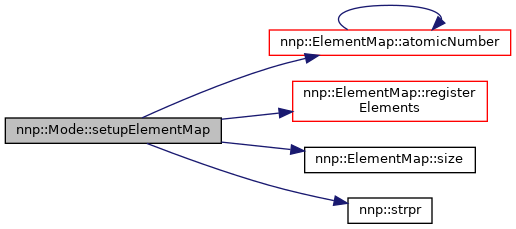

◆ setupElements()
|
virtual |
Set up all Element instances.
Uses keywords number_of_elements and atom_energy. This function should follow immediately after setupElementMap().
Reimplemented in nnp::ModeCabana< t_device >.
Definition at line 323 of file Mode.cpp.
References elementMap, elements, log, numElements, nnp::reduce(), settings, nnp::split(), and nnp::strpr().
Referenced by main(), and setupGeneric().
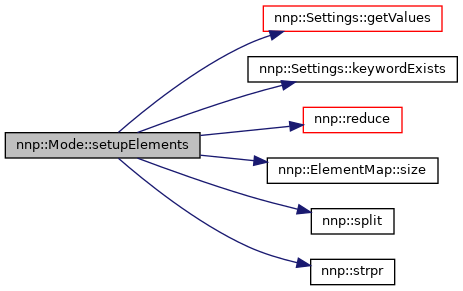

◆ setupCutoff()
| void Mode::setupCutoff | ( | ) |
Set up cutoff function for all symmetry functions.
Uses keyword cutoff_type. Cutoff parameters are read from settings keywords and stored internally. As soon as setupSymmetryFunctions() is called the settings are restored and used for all symmetry functions. Thus, this function must be called before setupSymmetryFunctions().
Definition at line 544 of file Mode.cpp.
References nnp::CutoffFunction::CT_COS, nnp::CutoffFunction::CT_EXP, nnp::CutoffFunction::CT_HARD, nnp::CutoffFunction::CT_POLY1, nnp::CutoffFunction::CT_POLY2, nnp::CutoffFunction::CT_POLY3, nnp::CutoffFunction::CT_POLY4, nnp::CutoffFunction::CT_TANH, nnp::CutoffFunction::CT_TANHU, cutoffAlpha, cutoffType, log, settings, nnp::split(), and nnp::strpr().
Referenced by main(), and setupGeneric().


◆ setupSymmetryFunctions()
|
virtual |
Set up all symmetry functions.
Uses keyword symfunction_short. Reads all symmetry functions from settings and automatically assigns them to the correct element.
Reimplemented in nnp::ModeCabana< t_device >.
Definition at line 639 of file Mode.cpp.
References convLength, cutoffAlpha, cutoffType, elementMap, elements, log, maxCutoffRadius, minCutoffRadius, minNeighbors, normalize, numElements, nnp::reduce(), settings, nnp::split(), and nnp::strpr().
Referenced by nnp::Training::dataSetNormalization(), main(), and setupGeneric().
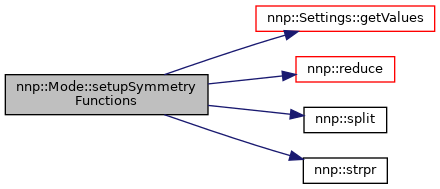

◆ setupSymmetryFunctionScalingNone()
| void Mode::setupSymmetryFunctionScalingNone | ( | ) |
Set up "empy" symmetry function scaling.
Does not use any keywords. Sets no scaling for all symmetry functions. Call after setupSymmetryFunctions(). Alternatively set scaling via setupSymmetryFunctionScaling().
Definition at line 716 of file Mode.cpp.
Referenced by main().

◆ setupSymmetryFunctionScaling()
|
virtual |
Set up symmetry function scaling from file.
- Parameters
-
[in] fileName Scaling file name.
Uses keywords scale_symmetry_functions, center_symmetry_functions, scale_symmetry_functions_sigma, scale_min_short and scale_max_short. Reads in scaling information and sets correct scaling behavior for all symmetry functions. Call after setupSymmetryFunctions().
Reimplemented in nnp::ModeCabana< t_device >.
Definition at line 736 of file Mode.cpp.
References elements, log, scalingType, settings, nnp::SymFnc::ST_CENTER, nnp::SymFnc::ST_NONE, nnp::SymFnc::ST_SCALE, nnp::SymFnc::ST_SCALECENTER, nnp::SymFnc::ST_SCALESIGMA, and nnp::strpr().
Referenced by nnp::Training::dataSetNormalization(), nnp::InterfaceLammps::initialize(), main(), and nnp::Prediction::setup().

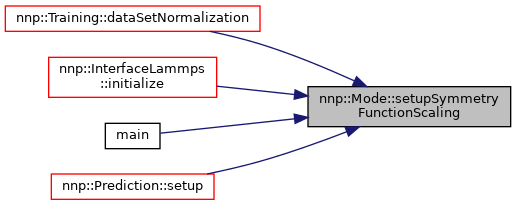
◆ setupSymmetryFunctionGroups()
|
virtual |
Set up symmetry function groups.
Does not use any keywords. Call after setupSymmetryFunctions() and ensure that correct scaling behavior has already been set.
Reimplemented in nnp::ModeCabana< t_device >.
Definition at line 866 of file Mode.cpp.
References elements, log, and nnp::strpr().
Referenced by nnp::Training::dataSetNormalization(), and setupGeneric().


◆ setupSymmetryFunctionCache()
|
virtual |
Set up symmetry function cache.
- Parameters
-
[in] verbose If true, print more cache information.
Searches symmetry functions for identical cutoff functions or compact function (i.e. all cachable stuff) and sets up a caching index.
Definition at line 1008 of file Mode.cpp.
References elementMap, elements, nnp::SymFnc::getCacheIdentifiers(), nnp::SymFnc::getIndex(), nnp::Element::getSymbol(), nnp::Element::getSymmetryFunction(), log, numElements, nnp::Element::numSymmetryFunctions(), nnp::Element::setCacheIndices(), nnp::split(), and nnp::strpr().
Referenced by nnp::Training::dataSetNormalization(), and setupGeneric().
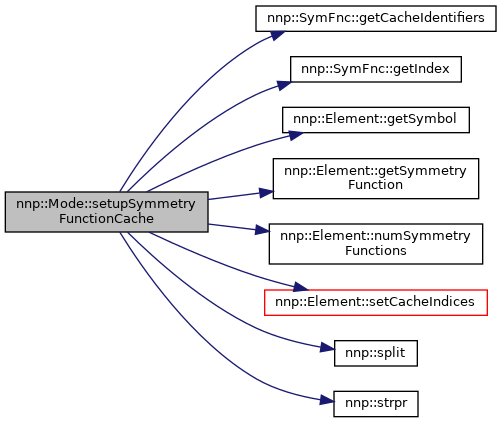

◆ setupSymmetryFunctionMemory()
| void Mode::setupSymmetryFunctionMemory | ( | bool | verbose = false | ) |
Extract required memory dimensions for symmetry function derivatives.
- Parameters
-
[in] verbose If true, print all symmetry function lines.
Call after symmetry functions have been set up and sorted.
Definition at line 918 of file Mode.cpp.
References elementMap, elements, nnp::SymFnc::getIndex(), nnp::SymFnc::getIndexPerElement(), log, numElements, nnp::SymFnc::parameterLine(), and nnp::strpr().
Referenced by nnp::Training::dataSetNormalization(), and setupGeneric().
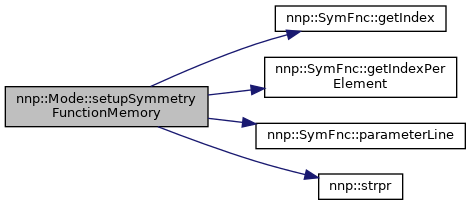

◆ setupSymmetryFunctionStatistics()
| void Mode::setupSymmetryFunctionStatistics | ( | bool | collectStatistics, |
| bool | collectExtrapolationWarnings, | ||
| bool | writeExtrapolationWarnings, | ||
| bool | stopOnExtrapolationWarnings ) |
Set up symmetry function statistics collection.
- Parameters
-
[in] collectStatistics Whether statistics (min, max, mean, sigma) is collected. [in] collectExtrapolationWarnings Whether extrapolation warnings are logged. [in] writeExtrapolationWarnings Write extrapolation warnings immediately when they occur. [in] stopOnExtrapolationWarnings Throw error immediately when an extrapolation warning occurs.
Does not use any keywords. Calling this setup function is not required, by default no statistics collection is enabled (all arguments false). Call after setupElements().
Definition at line 1127 of file Mode.cpp.
References checkExtrapolationWarnings, elements, log, and nnp::strpr().
Referenced by nnp::Training::dataSetNormalization(), nnp::InterfaceLammps::initialize(), main(), and nnp::Prediction::setup().

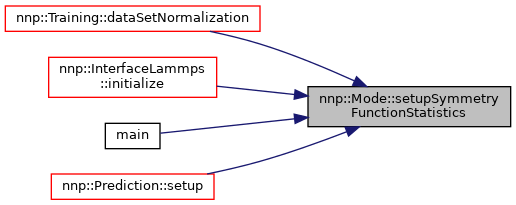
◆ setupCutoffMatrix()
| void Mode::setupCutoffMatrix | ( | ) |
Setup matrix storing all symmetry function cut-offs for each element.
Definition at line 1167 of file Mode.cpp.
References cutoffs, elements, numElements, screeningFunction, and nnp::vectorContains().
Referenced by setupGeneric().


◆ setupNeuralNetwork()
|
virtual |
Set up neural networks for all elements.
Uses keywords global_hidden_layers_short, global_nodes_short, global_activation_short, normalize_nodes. Call after setupSymmetryFunctions(), only then the number of input layer neurons is known.
Reimplemented in nnp::ModeCabana< t_device >.
Definition at line 1182 of file Mode.cpp.
References nnp::activationFromString(), nnp::Mode::NNSetup::Topology::activationFunctionsPerLayer, nnp::NeuralNetwork::AF_IDENTITY, nnp::NeuralNetwork::AF_UNSET, elementMap, elements, nnp::Element::getSymbol(), HDNNP_2G, HDNNP_4G, HDNNP_Q, nnp::Mode::NNSetup::id, nnp::Mode::NNSetup::keywordSuffix, log, nnp::Element::neuralNetworks, nnk, nnpType, nns, numElements, nnp::Mode::NNSetup::Topology::numLayers, nnp::Mode::NNSetup::Topology::numNeuronsPerLayer, nnp::reduce(), settings, nnp::split(), nnp::strpr(), and nnp::Mode::NNSetup::topology.
Referenced by setupGeneric().
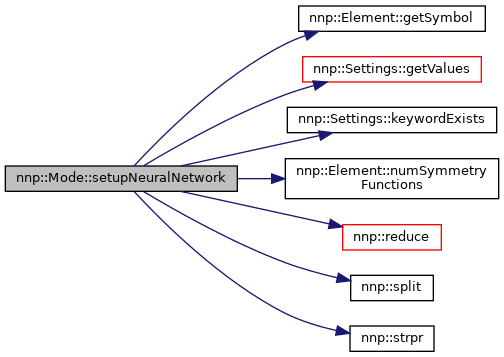

◆ setupNeuralNetworkWeights() [1/2]
|
virtual |
Set up neural network weights from files with given name format.
- Parameters
-
[in] fileNameFormats Map of NN ids to format for weight file names. Must contain a placeholder "%zu" for the element atomic number. Map keys are "short", "elec". Map argument may be ommitted, then default name formats are used.
Does not use any keywords. The weight files should contain one weight per line, see NeuralNetwork::setConnections() for the correct order.
Definition at line 1469 of file Mode.cpp.
References setupNeuralNetworkWeights().
Referenced by nnp::InterfaceLammps::initialize(), main(), nnp::Prediction::setup(), and setupNeuralNetworkWeights().

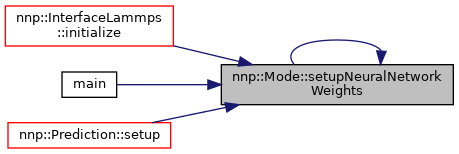
◆ setupNeuralNetworkWeights() [2/2]
|
virtual |
Set up neural network weights from files with given name format.
- Parameters
-
[in] directoryPrefix Directory prefix which is applied to all fileNameFormats. [in] fileNameFormats Map of NN ids to format for weight file names. Must contain a placeholder "%zu" for the element atomic number. Map keys are "short", "elec". Map argument may be ommitted, then default name formats are used.
Does not use any keywords. The weight files should contain one weight per line, see NeuralNetwork::setConnections() for the correct order.
Definition at line 1475 of file Mode.cpp.
References nnp::cap(), log, nnk, nns, readNeuralNetworkWeights(), and nnp::strpr().

◆ setupElectrostatics()
|
virtual |
Set up electrostatics related stuff (hardness, screening, ...).
- Parameters
-
[in] initialHardness Use initial hardness from keyword in settings file (useful for training). [in] directoryPrefix Directory prefix which is applied to fileNameFormat. [in] fileNameFormat Name format of file containing atomic hardness data.
Definition at line 369 of file Mode.cpp.
References convCharge, convEnergy, convLength, elementMap, elements, nnp::EWALD_SUM, nnp::EWALD_SUM_LAMMPS, ewaldSetup, fourPiEps, nnp::JACKSON_CATLOW, nnp::KOLAFA_PERRAM, kspaceGrid, log, normalize, normalized(), numElements, physical(), nnp::PPPM, nnp::readColumnsFromFile(), nnp::reduce(), screeningFunction, settings, nnp::split(), and nnp::strpr().
Referenced by setupGeneric().
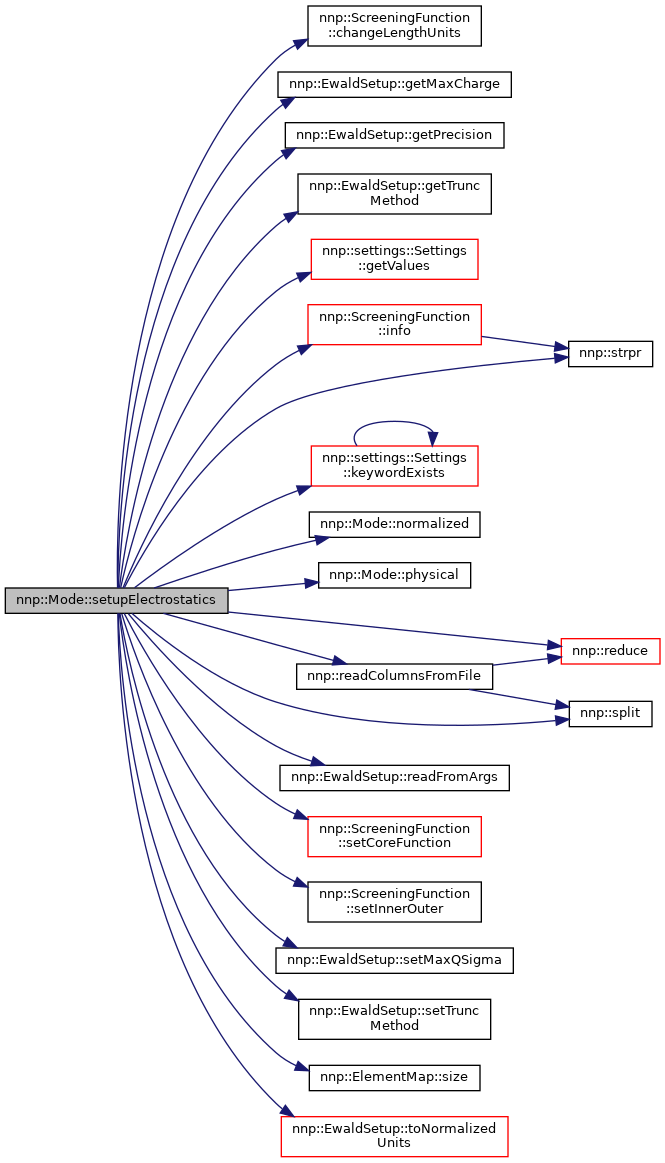

◆ calculateSymmetryFunctions()
| void Mode::calculateSymmetryFunctions | ( | Structure & | structure, |
| bool const | derivatives ) |
Calculate all symmetry functions for all atoms in given structure.
- Parameters
-
[in] structure Input structure. [in] derivatives If truecalculate also derivatives of symmetry functions.
This function should be replaced by calculateSymmetryFunctionGroups() whenever possible. Results are stored in Atom::G. If derivatives are calculated, additional results are stored in Atom::dGdr and Atom::Neighbor::dGdr.
Definition at line 1504 of file Mode.cpp.
References nnp::Atom::allocate(), nnp::Structure::atoms, nnp::Atom::cacheSizePerElement, nnp::Atom::calculateNumNeighbors(), nnp::Element::calculateSymmetryFunctions(), checkExtrapolationWarnings, nnp::Atom::element, elements, nnp::Element::getCacheSizes(), nnp::Element::getIndex(), nnp::Element::getSymmetryFunctionNumTable(), nnp::Atom::hasSymmetryFunctionDerivatives, nnp::Structure::hasSymmetryFunctionDerivatives, nnp::Atom::hasSymmetryFunctions, nnp::Structure::hasSymmetryFunctions, HDNNP_4G, HDNNP_Q, nnp::Atom::index, nnp::Atom::indexStructure, log, maxCutoffRadius, minCutoffRadius, minNeighbors, nnpType, nnp::Atom::numSymmetryFunctionDerivatives, nnp::Atom::numSymmetryFunctions, nnp::Element::numSymmetryFunctions(), nnp::strpr(), nnp::Element::updateSymmetryFunctionStatistics(), and nnp::Atom::useChargeNeuron.
Referenced by nnp::Training::calculateError(), nnp::Training::calculateWeightDerivatives(), nnp::Training::calculateWeightDerivatives(), nnp::Training::dataSetNormalization(), evaluateNNP(), main(), nnp::InterfaceLammps::process(), nnp::InterfaceLammps::processDevelop(), and nnp::Training::update().
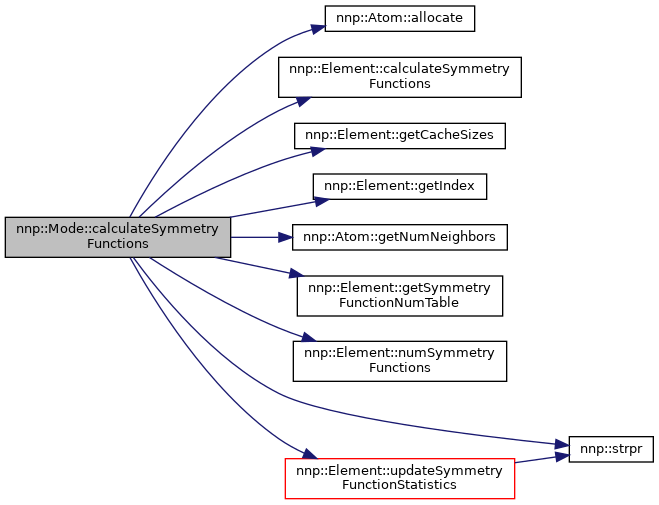
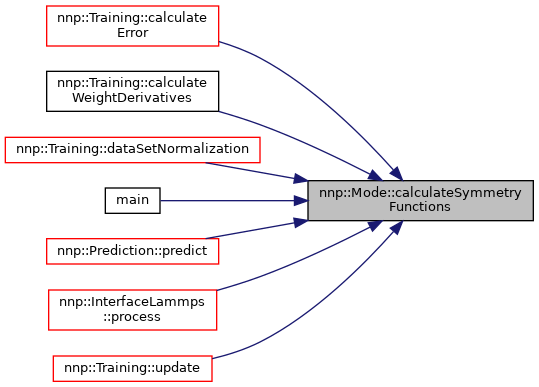
◆ calculateSymmetryFunctionGroups()
| void Mode::calculateSymmetryFunctionGroups | ( | Structure & | structure, |
| bool const | derivatives ) |
Calculate all symmetry function groups for all atoms in given structure.
- Parameters
-
[in] structure Input structure. [in] derivatives If truecalculate also derivatives of symmetry functions.
This function replaces calculateSymmetryFunctions() when symmetry function groups are enabled (faster, default behavior). Results are stored in Atom::G. If derivatives are calculated, additional results are stored in Atom::dGdr and Atom::Neighbor::dGdr.
Definition at line 1585 of file Mode.cpp.
References nnp::Atom::allocate(), nnp::Structure::atoms, nnp::Atom::cacheSizePerElement, nnp::Atom::calculateNumNeighbors(), nnp::Element::calculateSymmetryFunctionGroups(), checkExtrapolationWarnings, nnp::Atom::element, elements, nnp::Element::getCacheSizes(), nnp::Element::getIndex(), nnp::Element::getSymmetryFunctionNumTable(), nnp::Atom::hasSymmetryFunctionDerivatives, nnp::Structure::hasSymmetryFunctionDerivatives, nnp::Atom::hasSymmetryFunctions, nnp::Structure::hasSymmetryFunctions, HDNNP_4G, HDNNP_Q, nnp::Atom::index, nnp::Atom::indexStructure, log, maxCutoffRadius, minCutoffRadius, minNeighbors, nnpType, nnp::Atom::numSymmetryFunctionDerivatives, nnp::Atom::numSymmetryFunctions, nnp::Element::numSymmetryFunctions(), nnp::strpr(), nnp::Element::updateSymmetryFunctionStatistics(), and nnp::Atom::useChargeNeuron.
Referenced by nnp::Training::calculateError(), nnp::Training::calculateWeightDerivatives(), nnp::Training::calculateWeightDerivatives(), nnp::Training::dataSetNormalization(), evaluateNNP(), main(), nnp::InterfaceLammps::process(), nnp::InterfaceLammps::processDevelop(), and nnp::Training::update().
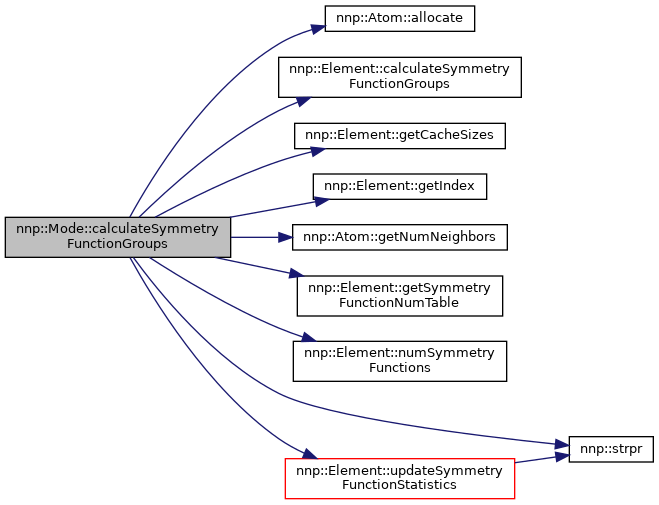
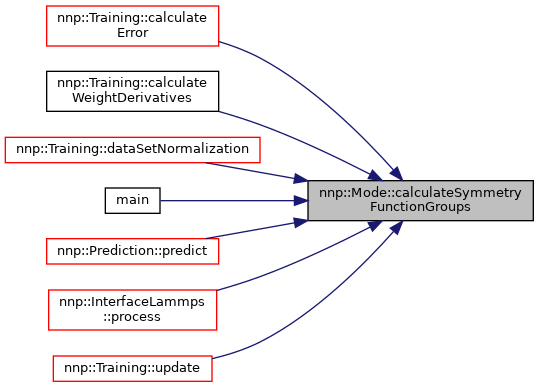
◆ calculateAtomicNeuralNetworks()
| void Mode::calculateAtomicNeuralNetworks | ( | Structure & | structure, |
| bool const | derivatives, | ||
| std::string | id = "" ) |
Calculate a single atomic neural network for a given atom and nn type.
- Parameters
-
[in] nnId Neural network identifier, e.g. "short", "charge". [in] atom Input atom. [in] derivatives If truecalculate also derivatives of neural networks with respect to input layer neurons (required for force calculation).
The atomic energy and charge is stored in Atom::energy and Atom::charge, respectively. If derivatives are calculated the results are stored in Atom::dEdG or Atom::dQdG. Calculate atomic neural networks for all atoms in given structure.
- Parameters
-
[in] structure Input structure. [in] derivatives If truecalculate also derivatives of neural networks with respect to input layer neurons (required for force calculation).[in] id Neural network ID to use. If empty, the first entry nnk.front() is used.
Definition at line 1666 of file Mode.cpp.
References nnp::Structure::atoms, nnp::NeuralNetwork::calculateDEdG(), elements, nnp::NeuralNetwork::getOutput(), HDNNP_2G, HDNNP_4G, HDNNP_Q, nnk, nnpType, normalize, normalized(), nnp::NeuralNetwork::propagate(), and nnp::NeuralNetwork::setInput().
Referenced by nnp::Training::calculateError(), nnp::Training::dataSetNormalization(), nnp::Training::dPdcN(), evaluateNNP(), main(), nnp::InterfaceLammps::process(), nnp::InterfaceLammps::processDevelop(), and nnp::Training::update().
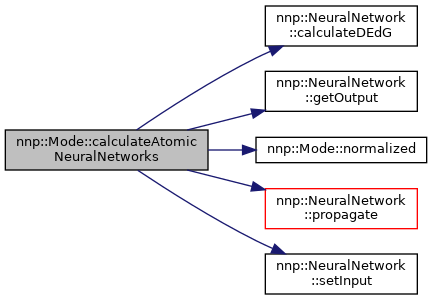
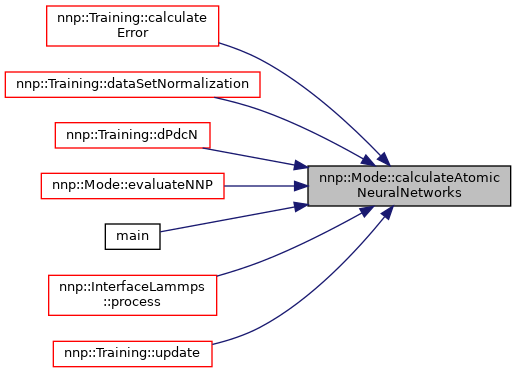
◆ chargeEquilibration()
| void Mode::chargeEquilibration | ( | Structure & | structure, |
| bool const | derivativesElec ) |
Perform global charge equilibration method.
- Parameters
-
[in] structure Input structure. [in] derivativesElec Turn on/off calculation of dElecdQ and pElecpr (Typically needed for elecstrosttic forces).
Definition at line 1779 of file Mode.cpp.
References nnp::Structure::calculateDAdrQ(), nnp::Structure::calculateElectrostaticEnergy(), nnp::Structure::calculateElectrostaticEnergyDerivatives(), convCharge, convEnergy, convLength, elements, erfcBuf, ewaldSetup, fourPiEps, normalize, numElements, and screeningFunction.
Referenced by nnp::Training::calculateError(), evaluateNNP(), nnp::InterfaceLammps::processDevelop(), and nnp::Training::update().
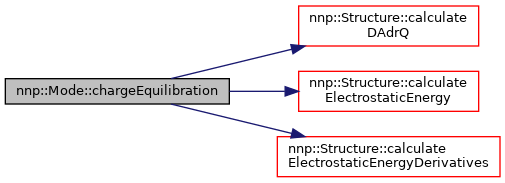
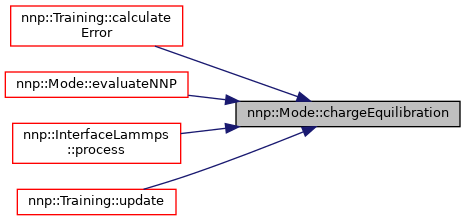
◆ calculateEnergy()
| void Mode::calculateEnergy | ( | Structure & | structure | ) | const |
Calculate potential energy for a given structure.
- Parameters
-
[in] structure Input structure.
Sum up potential energy from atomic energy contributions. Result is stored in Structure::energy.
Definition at line 1831 of file Mode.cpp.
References nnp::Structure::atoms, nnp::Structure::energy, nnp::Structure::energyElec, and nnp::Structure::energyShort.
Referenced by nnp::Training::calculateError(), nnp::Training::dataSetNormalization(), nnp::Training::dPdcN(), evaluateNNP(), main(), nnp::InterfaceLammps::process(), nnp::InterfaceLammps::processDevelop(), and nnp::Training::update().
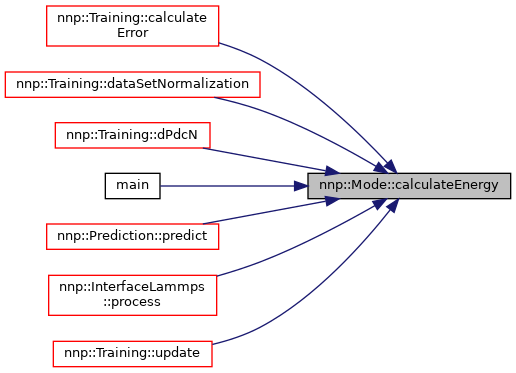
◆ calculateCharge()
| void Mode::calculateCharge | ( | Structure & | structure | ) | const |
Calculate total charge for a given structure.
- Parameters
-
[in] structure Input structure.
Sum up charge from atomic charge contributions. Result is stored in Structure::charge.
Definition at line 1858 of file Mode.cpp.
References nnp::Structure::atoms, and nnp::Structure::charge.
Referenced by evaluateNNP(), and nnp::InterfaceLammps::processDevelop().

◆ calculateForces()
| void Mode::calculateForces | ( | Structure & | structure | ) | const |
Calculate forces for all atoms in given structure.
- Parameters
-
[in] structure Input structure.
Combine intermediate results from symmetry function and neural network computation to atomic forces. Results are stored in Atom::f.
Definition at line 1877 of file Mode.cpp.
References nnp::Structure::atoms, nnp::Atom::calculateDChidr(), nnp::Structure::calculateForceLambdaElec(), nnp::Structure::calculateForceLambdaTotal(), nnp::Atom::calculatePairForceShort(), nnp::Atom::calculateSelfForceShort(), nnp::Atom::element, elements, nnp::Atom::f, nnp::Atom::getStoredMinNumNeighbors(), HDNNP_4G, HDNNP_Q, nnp::Atom::index, nnp::Atom::Neighbor::index, maxCutoffRadius, nnp::Atom::neighbors, nnp::Atom::neighborsUnique, nnpType, and nnp::Structure::numAtoms.
Referenced by nnp::Training::calculateError(), nnp::Training::dataSetNormalization(), nnp::Training::dPdcN(), evaluateNNP(), main(), and nnp::Training::update().
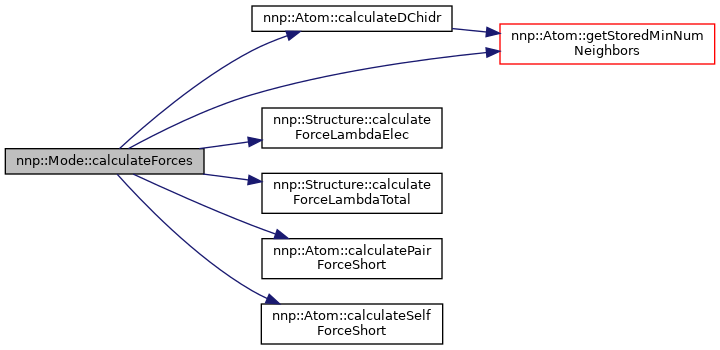
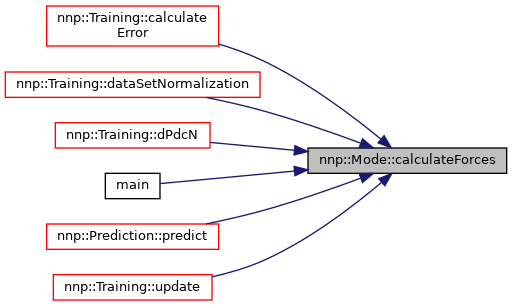
◆ evaluateNNP()
| void Mode::evaluateNNP | ( | Structure & | structure, |
| bool | useForces = true, | ||
| bool | useDEdG = true ) |
Evaluate neural network potential (includes total energy, optionally forces and in some cases charges.
- Parameters
-
[in] structure Input structure. [in] useForces If true, calculate forces too. [in] useDEdG If true, calculate dE/dG too.
Definition at line 1984 of file Mode.cpp.
References nnp::Structure::atoms, calculateAtomicNeuralNetworks(), calculateCharge(), calculateEnergy(), calculateForces(), nnp::Structure::calculateMaxCutoffRadiusOverall(), nnp::Structure::calculateNeighborList(), calculateSymmetryFunctionGroups(), calculateSymmetryFunctions(), chargeEquilibration(), cutoffs, ewaldSetup, HDNNP_4G, HDNNP_Q, maxCutoffRadius, nnpType, and screeningFunction.
Referenced by main(), and nnp::Prediction::predict().
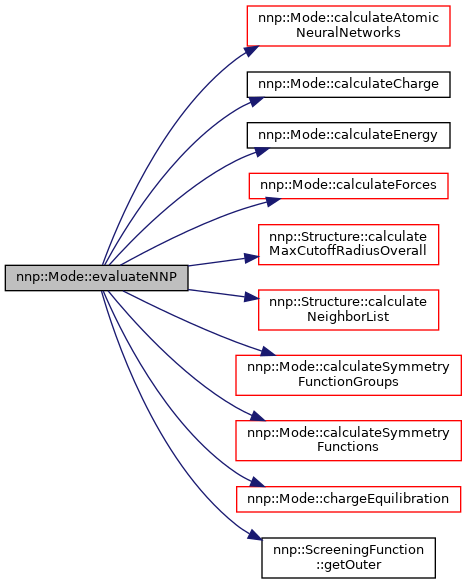

◆ addEnergyOffset()
| void Mode::addEnergyOffset | ( | Structure & | structure, |
| bool | ref = true ) |
Add atomic energy offsets to reference energy.
- Parameters
-
[in] structure Input structure. [in] ref If true, use reference energy, otherwise use NN energy.
Definition at line 2034 of file Mode.cpp.
References elements, nnp::Structure::energy, nnp::Structure::energyRef, nnp::Structure::numAtomsPerElement, and numElements.
Referenced by main(), nnp::Prediction::predict(), nnp::InterfaceLammps::process(), nnp::InterfaceLammps::processDevelop(), and nnp::Training::writeSetsToFiles().
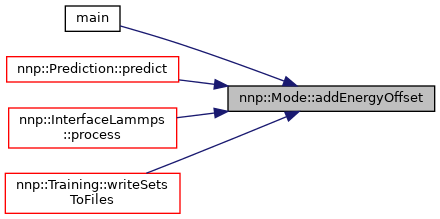
◆ removeEnergyOffset()
| void Mode::removeEnergyOffset | ( | Structure & | structure, |
| bool | ref = true ) |
Remove atomic energy offsets from reference energy.
- Parameters
-
[in] structure Input structure. [in] ref If true, use reference energy, otherwise use NN energy.
This function should be called immediately after structures are read in.
Definition at line 2053 of file Mode.cpp.
References elements, nnp::Structure::energy, nnp::Structure::energyRef, nnp::Structure::numAtomsPerElement, and numElements.
Referenced by nnp::Dataset::distributeStructures(), nnp::Prediction::readStructureFromFile(), and nnp::Training::writeSetsToFiles().
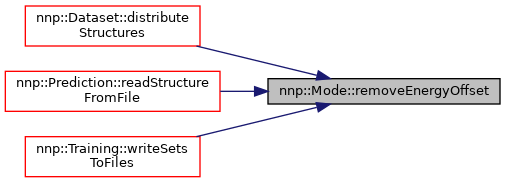
◆ getEnergyOffset()
| double Mode::getEnergyOffset | ( | Structure const & | structure | ) | const |
Get atomic energy offset for given structure.
- Parameters
-
[in] structure Input structure.
- Returns
- Summed atomic energy offsets for structure.
Definition at line 2072 of file Mode.cpp.
References elements, nnp::Structure::numAtomsPerElement, and numElements.
Referenced by main(), and nnp::Dataset::writeSymmetryFunctionFile().

◆ getEnergyWithOffset()
| double Mode::getEnergyWithOffset | ( | Structure const & | structure, |
| bool | ref = true ) const |
Add atomic energy offsets and return energy.
- Parameters
-
[in] structure Input structure. [in] ref If true, use reference energy, otherwise use NN energy.
- Returns
- Reference or NNP energy with energy offsets added.
- Note
- If normalization is used, ensure that structure energy is already in physical units.
Definition at line 2085 of file Mode.cpp.
References elements, nnp::Structure::energy, nnp::Structure::energyRef, nnp::Structure::numAtomsPerElement, and numElements.
Referenced by nnp::Training::dataSetNormalization(), and main().

◆ normalized()
| double Mode::normalized | ( | std::string const & | property, |
| double | value ) const |
Apply normalization to given property.
- Parameters
-
[in] property One of "energy", "force", "charge", "hardness" "negativity". [in] value Input property value in physical units.
- Returns
- Property in normalized units.
Definition at line 2100 of file Mode.cpp.
References convCharge, convEnergy, and convLength.
Referenced by calculateAtomicNeuralNetworks(), setupElectrostatics(), and nnp::Training::update().

◆ normalizedEnergy()
| double Mode::normalizedEnergy | ( | Structure const & | structure, |
| bool | ref = true ) const |
Apply normalization to given energy of structure.
- Parameters
-
[in] structure Input structure with energy in physical units. [in] ref If true, use reference energy, otherwise use NN energy.
- Returns
- Energy in normalized units.
Definition at line 2112 of file Mode.cpp.
References convEnergy, nnp::Structure::energy, nnp::Structure::energyRef, meanEnergy, and nnp::Structure::numAtoms.
◆ physical()
| double Mode::physical | ( | std::string const & | property, |
| double | value ) const |
Undo normalization for a given property.
- Parameters
-
[in] property One of "energy", "force", "charge", "hardness", "negativity". [in] value Input property value in normalized units.
- Returns
- Property in physical units.
Definition at line 2126 of file Mode.cpp.
References convCharge, convEnergy, and convLength.
Referenced by nnp::InterfaceLammps::getAtomicEnergy(), main(), nnp::Training::printEpoch(), setupElectrostatics(), nnp::Training::writeHardness(), and nnp::Training::writeLearningCurve().
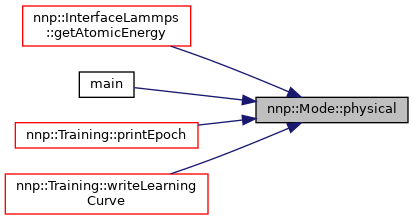
◆ physicalEnergy()
| double Mode::physicalEnergy | ( | Structure const & | structure, |
| bool | ref = true ) const |
Undo normalization for a given energy of structure.
- Parameters
-
[in] structure Input structure with energy in normalized units. [in] ref If true, use reference energy, otherwise use NN energy.
- Returns
- Energy in physical units.
Definition at line 2138 of file Mode.cpp.
References convEnergy, nnp::Structure::energy, nnp::Structure::energyRef, meanEnergy, and nnp::Structure::numAtoms.
Referenced by main(), nnp::InterfaceLammps::process(), nnp::InterfaceLammps::processDevelop(), and nnp::Dataset::writeSymmetryFunctionFile().
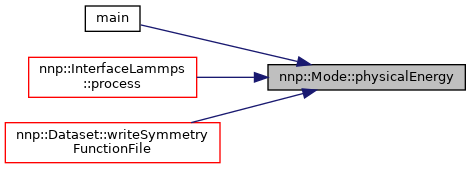
◆ convertToNormalizedUnits()
| void Mode::convertToNormalizedUnits | ( | Structure & | structure | ) | const |
Convert one structure to normalized units.
- Parameters
-
[in,out] structure Input structure.
Definition at line 2151 of file Mode.cpp.
References convCharge, convEnergy, convLength, meanEnergy, and nnp::Structure::toNormalizedUnits().

◆ convertToPhysicalUnits()
| void Mode::convertToPhysicalUnits | ( | Structure & | structure | ) | const |
Convert one structure to physical units.
- Parameters
-
[in,out] structure Input structure.
Definition at line 2158 of file Mode.cpp.
References convCharge, convEnergy, convLength, meanEnergy, and nnp::Structure::toPhysicalUnits().
Referenced by main().


◆ logEwaldCutoffs()
| void Mode::logEwaldCutoffs | ( | ) |
Logs Ewald params whenever they change.
Definition at line 2165 of file Mode.cpp.
References convLength, ewaldSetup, HDNNP_4G, log, and nnpType.
Referenced by main().

◆ getNumExtrapolationWarnings()
| size_t Mode::getNumExtrapolationWarnings | ( | ) | const |
Count total number of extrapolation warnings encountered for all elements and symmetry functions.
- Returns
- Number of extrapolation warnings.
Definition at line 2182 of file Mode.cpp.
References elements.
Referenced by main().

◆ resetExtrapolationWarnings()
| void Mode::resetExtrapolationWarnings | ( | ) |
Erase all extrapolation warnings and reset counters.
Definition at line 2171 of file Mode.cpp.
References elements.
Referenced by main().

◆ getNnpType()
|
inline |
◆ getMeanEnergy()
|
inline |
Getter for Mode::meanEnergy.
- Returns
- Mean energy per atom.
Definition at line 710 of file Mode.h.
References meanEnergy.
Referenced by main().

◆ getConvEnergy()
|
inline |
Getter for Mode::convEnergy.
- Returns
- Energy unit conversion factor.
Definition at line 715 of file Mode.h.
References convEnergy.
Referenced by main().

◆ getConvLength()
|
inline |
Getter for Mode::convLength.
- Returns
- Length unit conversion factor.
Definition at line 720 of file Mode.h.
References convLength.
Referenced by main().

◆ getConvCharge()
|
inline |
Getter for Mode::convCharge.
- Returns
- Charge unit conversion factor.
Definition at line 725 of file Mode.h.
References convCharge.
Referenced by main().

◆ getEwaldPrecision()
|
inline |
Getter for Mode::ewaldSetup.precision.
- Returns
- Ewald precision in 4G-HDNNPs.
Definition at line 740 of file Mode.h.
References ewaldSetup.
Referenced by nnp::InterfaceLammps::getEwaldPrec().

◆ getEwaldMaxCharge()
|
inline |
Getter for Mode::ewaldSetup.maxCharge.
- Returns
- Ewald max charge if specified in 4G-HDNNPs.
Definition at line 745 of file Mode.h.
References ewaldSetup.
◆ getEwaldMaxSigma()
|
inline |
Getter for Mode::ewaldSetup.maxQsigma.
- Returns
- Ewald max sigma parameter in 4G-HDNNPs.
Definition at line 750 of file Mode.h.
References ewaldSetup.
◆ getEwaldTruncationMethod()
|
inline |
Getter for Mode::ewaldSetup.truncMethod.
- Returns
- Ewald truncation method in 4G-HDNNPs.
Definition at line 755 of file Mode.h.
References ewaldSetup.
◆ kspaceSolver()
|
inline |
Getter for Mode::kspaceSolver.
- Returns
- K-space solver to be used in 4G-HDNNPs.
Definition at line 760 of file Mode.h.
References kspaceGrid.
◆ getMaxCutoffRadius()
|
inline |
Getter for Mode::maxCutoffRadius.
- Returns
- Maximum cutoff radius of all symmetry functions.
The maximum cutoff radius is determined by setupSymmetryFunctions().
Definition at line 730 of file Mode.h.
References maxCutoffRadius.
Referenced by main(), and nnp::SetupAnalysis::writeSymmetryFunctionShape().

◆ getNumElements()
|
inline |
Getter for Mode::numElements.
- Returns
- Number of elements defined.
The number of elements is determined by setupElements().
Definition at line 735 of file Mode.h.
References numElements.
Referenced by main().

◆ getScreeningFunction()
| ScreeningFunction nnp::Mode::getScreeningFunction | ( | ) | const |
Getter for Mode::screeningFunction.
- Returns
- Copy of screening function instance.
◆ getNumSymmetryFunctions()
| vector< size_t > Mode::getNumSymmetryFunctions | ( | ) | const |
Get number of symmetry functions per element.
- Returns
- Vector with number of symmetry functions for each element.
Definition at line 2196 of file Mode.cpp.
References elements.
Referenced by main().

◆ useNormalization()
|
inline |
◆ settingsKeywordExists()
| bool Mode::settingsKeywordExists | ( | std::string const & | keyword | ) | const |
◆ settingsGetValue()
| string Mode::settingsGetValue | ( | std::string const & | keyword | ) | const |
◆ pruneSymmetryFunctionsRange()
| vector< size_t > Mode::pruneSymmetryFunctionsRange | ( | double | threshold | ) |
Prune symmetry functions according to their range and write settings file.
- Parameters
-
[in] threshold Symmetry functions with range (max - min) smaller than this threshold will be pruned.
- Returns
- List of line numbers with symmetry function to be removed.
Definition at line 2244 of file Mode.cpp.
References elements, nnp::SymFnc::getGmax(), and nnp::SymFnc::getGmin().
Referenced by main().


◆ pruneSymmetryFunctionsSensitivity()
| vector< size_t > Mode::pruneSymmetryFunctionsSensitivity | ( | double | threshold, |
| std::vector< std::vector< double > > | sensitivity ) |
Prune symmetry functions with sensitivity analysis data.
- Parameters
-
[in] threshold Symmetry functions with sensitivity lower than this threshold will be pruned. [in] sensitivity Sensitivity data for each element and symmetry function.
- Returns
- List of line numbers with symmetry function to be removed.
Definition at line 2265 of file Mode.cpp.
References elements, and numElements.
Referenced by main().

◆ writePrunedSettingsFile()
| void Mode::writePrunedSettingsFile | ( | std::vector< std::size_t > | prune, |
| std::string | fileName = "output.nn" ) const |
Copy settings file but comment out lines provided.
- Parameters
-
[in] prune List of line numbers to comment out. [in] fileName Output file name.
Definition at line 2220 of file Mode.cpp.
References settings.
Referenced by main().

◆ writeSettingsFile()
| void Mode::writeSettingsFile | ( | std::ofstream *const & | file | ) | const |
Write complete settings file.
- Parameters
-
[in,out] file Settings file.
Definition at line 2237 of file Mode.cpp.
References settings.
Referenced by nnp::Training::dataSetNormalization(), and main().

◆ readNeuralNetworkWeights()
|
protected |
Read in weights for a specific type of neural network.
- Parameters
-
[in] id Actual network type to initialize ("short" or "elec"). [in] fileNameFormat Weights file name format.
Definition at line 2286 of file Mode.cpp.
References elements, log, nnp::readColumnsFromFile(), nnp::NeuralNetwork::setConnections(), and nnp::strpr().
Referenced by nnp::Training::initializeWeights(), setupNeuralNetworkWeights(), and nnp::Training::setupNumericDerivCheck().

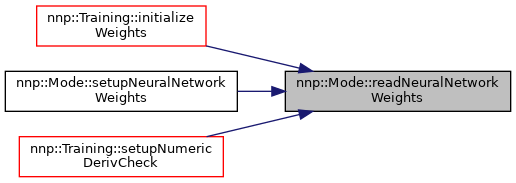
Member Data Documentation
◆ elementMap
| ElementMap nnp::Mode::elementMap |
Global element map, populated by setupElementMap().
Definition at line 627 of file Mode.h.
Referenced by nnp::Dataset::distributeStructures(), nnp::InterfaceLammps::initialize(), main(), nnp::Dataset::prepareNumericForces(), nnp::Prediction::readStructureFromFile(), nnp::Training::selectSets(), setupElectrostatics(), setupElementMap(), setupElements(), setupNeuralNetwork(), setupSymmetryFunctionCache(), setupSymmetryFunctionMemory(), setupSymmetryFunctions(), nnp::Dataset::writeAtomicEnvironmentFile(), nnp::Dataset::writeNeighborLists(), nnp::Dataset::writeSymmetryFunctionFile(), nnp::Dataset::writeSymmetryFunctionHistograms(), and nnp::Training::writeUpdaterStatus().
◆ log
| Log nnp::Mode::log |
Global log file.
Definition at line 629 of file Mode.h.
Referenced by nnp::Training::allocateArrays(), nnp::Training::calculateNeighborLists(), calculateSymmetryFunctionGroups(), calculateSymmetryFunctions(), nnp::Training::checkSelectionMode(), nnp::Dataset::collectSymmetryFunctionStatistics(), nnp::Training::dataSetNormalization(), nnp::Dataset::distributeStructures(), nnp::InterfaceLammps::initialize(), initialize(), nnp::Training::initializeWeights(), nnp::Training::initializeWeightsMemory(), loadSettingsFile(), logEwaldCutoffs(), nnp::Training::loop(), main(), nnp::Training::printEpoch(), nnp::Training::printHeader(), nnp::InterfaceLammps::processDevelop(), nnp::Training::randomizeNeuralNetworkWeights(), readNeuralNetworkWeights(), nnp::Training::selectSets(), setupCutoff(), setupElectrostatics(), setupElementMap(), setupElements(), nnp::Training::setupFileOutput(), nnp::Dataset::setupMPI(), setupNeuralNetwork(), setupNeuralNetworkWeights(), setupNormalization(), nnp::Training::setupNumericDerivCheck(), nnp::Dataset::setupRandomNumberGenerator(), nnp::Training::setupSelectionMode(), setupSymmetryFunctionCache(), setupSymmetryFunctionGroups(), setupSymmetryFunctionMemory(), setupSymmetryFunctions(), setupSymmetryFunctionScaling(), setupSymmetryFunctionScalingNone(), setupSymmetryFunctionStatistics(), nnp::Training::setupTraining(), nnp::Training::setupUpdatePlan(), nnp::Dataset::sortNeighborLists(), nnp::Dataset::writeAtomicEnvironmentFile(), nnp::InterfaceLammps::writeExtrapolationWarnings(), nnp::Dataset::writeNeighborHistogram(), nnp::Dataset::writeNeighborLists(), nnp::Training::writeSetsToFiles(), nnp::Dataset::writeSymmetryFunctionFile(), nnp::Dataset::writeSymmetryFunctionHistograms(), nnp::Dataset::writeSymmetryFunctionScaling(), and nnp::SetupAnalysis::writeSymmetryFunctionShape().
◆ nnpType
|
protected |
Definition at line 664 of file Mode.h.
Referenced by calculateAtomicNeuralNetworks(), nnp::Training::calculateError(), calculateForces(), nnp::Training::calculateNeighborLists(), calculateSymmetryFunctionGroups(), calculateSymmetryFunctions(), nnp::Training::collectDGdxia(), nnp::Training::dataSetNormalization(), evaluateNNP(), nnp::InterfaceLammps::finalizeNeighborList(), nnp::InterfaceLammps::getCharges(), nnp::InterfaceLammps::getForcesDevelop(), nnp::InterfaceLammps::getMaxCutoffRadiusOverall(), getNnpType(), nnp::Training::getWeights(), nnp::Training::initializeWeights(), nnp::Training::initializeWeightsMemory(), loadSettingsFile(), logEwaldCutoffs(), Mode(), nnp::InterfaceLammps::process(), nnp::InterfaceLammps::processDevelop(), nnp::Training::selectSets(), nnp::Training::setStage(), setupGeneric(), setupNeuralNetwork(), nnp::Training::setupNumericDerivCheck(), nnp::Training::setupTraining(), nnp::Training::setWeights(), nnp::Training::update(), nnp::Training::writeHardnessEpoch(), nnp::Training::writeLearningCurve(), nnp::Training::writeNeuronStatisticsEpoch(), nnp::Training::writeTimingData(), nnp::Training::writeUpdaterStatus(), and nnp::Training::writeWeightsEpoch().
◆ normalize
|
protected |
Definition at line 665 of file Mode.h.
Referenced by nnp::InterfaceLammps::addNeighbor(), calculateAtomicNeuralNetworks(), nnp::Training::calculateNeighborLists(), chargeEquilibration(), nnp::Training::dataSetNormalization(), nnp::InterfaceLammps::getAtomicEnergy(), nnp::InterfaceLammps::getForces(), nnp::InterfaceLammps::getForcesChi(), nnp::InterfaceLammps::getForcesDevelop(), nnp::InterfaceLammps::getMaxCutoffRadius(), nnp::InterfaceLammps::getMaxCutoffRadiusOverall(), Mode(), nnp::Prediction::predict(), nnp::Training::printEpoch(), nnp::InterfaceLammps::process(), nnp::InterfaceLammps::processDevelop(), nnp::Prediction::readStructureFromFile(), nnp::InterfaceLammps::setBoxVectors(), nnp::InterfaceLammps::setLocalAtomPositions(), setupElectrostatics(), setupNormalization(), setupSymmetryFunctions(), nnp::Training::update(), useNormalization(), nnp::Training::writeHardness(), nnp::Training::writeLearningCurve(), and nnp::Dataset::writeSymmetryFunctionFile().
◆ checkExtrapolationWarnings
|
protected |
Definition at line 666 of file Mode.h.
Referenced by calculateSymmetryFunctionGroups(), calculateSymmetryFunctions(), Mode(), and setupSymmetryFunctionStatistics().
◆ numElements
|
protected |
Definition at line 667 of file Mode.h.
Referenced by addEnergyOffset(), nnp::Training::calculateWeightDerivatives(), nnp::Training::calculateWeightDerivatives(), chargeEquilibration(), nnp::Training::dPdcN(), getEnergyOffset(), getEnergyWithOffset(), getNumElements(), nnp::InterfaceLammps::getQEqParams(), nnp::Training::getWeights(), nnp::Training::initializeWeightsMemory(), Mode(), pruneSymmetryFunctionsSensitivity(), nnp::Training::randomizeNeuralNetworkWeights(), removeEnergyOffset(), nnp::Training::selectSets(), nnp::InterfaceLammps::setLocalAtoms(), setupCutoffMatrix(), setupElectrostatics(), setupElements(), setupNeuralNetwork(), setupSymmetryFunctionCache(), setupSymmetryFunctionMemory(), setupSymmetryFunctions(), nnp::Training::setWeights(), nnp::Training::update(), nnp::Dataset::writeAtomicEnvironmentFile(), nnp::Training::writeHardness(), nnp::Dataset::writeNeighborLists(), nnp::Training::writeNeuronStatistics(), nnp::SetupAnalysis::writeSymmetryFunctionShape(), and nnp::Training::writeWeights().
◆ minNeighbors
|
protected |
Definition at line 668 of file Mode.h.
Referenced by calculateSymmetryFunctionGroups(), calculateSymmetryFunctions(), setupSymmetryFunctions(), and nnp::Dataset::writeNeighborHistogram().
◆ minCutoffRadius
|
protected |
Definition at line 669 of file Mode.h.
Referenced by calculateSymmetryFunctionGroups(), calculateSymmetryFunctions(), and setupSymmetryFunctions().
◆ maxCutoffRadius
|
protected |
Definition at line 670 of file Mode.h.
Referenced by nnp::Training::calculateError(), calculateForces(), nnp::Training::calculateNeighborLists(), calculateSymmetryFunctionGroups(), calculateSymmetryFunctions(), nnp::Training::calculateWeightDerivatives(), nnp::Training::dataSetNormalization(), evaluateNNP(), nnp::InterfaceLammps::finalizeNeighborList(), nnp::InterfaceLammps::getdChidxyz(), nnp::InterfaceLammps::getForcesDevelop(), nnp::InterfaceLammps::getMaxCutoffRadius(), getMaxCutoffRadius(), nnp::InterfaceLammps::getMaxCutoffRadiusOverall(), Mode(), setupSymmetryFunctions(), and nnp::Training::update().
◆ cutoffAlpha
|
protected |
Definition at line 671 of file Mode.h.
Referenced by Mode(), setupCutoff(), and setupSymmetryFunctions().
◆ meanEnergy
|
protected |
Definition at line 672 of file Mode.h.
Referenced by convertToNormalizedUnits(), convertToPhysicalUnits(), nnp::Training::dataSetNormalization(), nnp::InterfaceLammps::getAtomicEnergy(), getMeanEnergy(), Mode(), normalizedEnergy(), physicalEnergy(), nnp::Prediction::predict(), nnp::Prediction::readStructureFromFile(), setupNormalization(), nnp::Dataset::toNormalizedUnits(), nnp::Dataset::toPhysicalUnits(), and nnp::InterfaceLammps::writeToFile().
◆ convEnergy
|
protected |
Definition at line 673 of file Mode.h.
Referenced by chargeEquilibration(), convertToNormalizedUnits(), convertToPhysicalUnits(), nnp::Training::dataSetNormalization(), getConvEnergy(), nnp::InterfaceLammps::getForces(), nnp::InterfaceLammps::getForcesChi(), nnp::InterfaceLammps::getForcesDevelop(), Mode(), normalized(), normalizedEnergy(), physical(), physicalEnergy(), nnp::Prediction::predict(), nnp::Prediction::readStructureFromFile(), setupElectrostatics(), setupNormalization(), nnp::Dataset::toNormalizedUnits(), nnp::Dataset::toPhysicalUnits(), and nnp::InterfaceLammps::writeToFile().
◆ convLength
|
protected |
Definition at line 674 of file Mode.h.
Referenced by nnp::InterfaceLammps::addNeighbor(), nnp::Training::calculateNeighborLists(), chargeEquilibration(), convertToNormalizedUnits(), convertToPhysicalUnits(), nnp::Training::dataSetNormalization(), getConvLength(), nnp::InterfaceLammps::getForces(), nnp::InterfaceLammps::getForcesChi(), nnp::InterfaceLammps::getForcesDevelop(), nnp::InterfaceLammps::getMaxCutoffRadius(), nnp::InterfaceLammps::getMaxCutoffRadiusOverall(), logEwaldCutoffs(), Mode(), normalized(), physical(), nnp::Prediction::predict(), nnp::InterfaceLammps::processDevelop(), nnp::Prediction::readStructureFromFile(), nnp::InterfaceLammps::setBoxVectors(), nnp::InterfaceLammps::setLocalAtomPositions(), setupElectrostatics(), setupNormalization(), setupSymmetryFunctions(), nnp::Dataset::toNormalizedUnits(), nnp::Dataset::toPhysicalUnits(), and nnp::InterfaceLammps::writeToFile().
◆ convCharge
|
protected |
Definition at line 675 of file Mode.h.
Referenced by chargeEquilibration(), convertToNormalizedUnits(), convertToPhysicalUnits(), getConvCharge(), Mode(), normalized(), physical(), nnp::Prediction::predict(), nnp::Prediction::readStructureFromFile(), setupElectrostatics(), setupNormalization(), nnp::Dataset::toNormalizedUnits(), nnp::Dataset::toPhysicalUnits(), and nnp::InterfaceLammps::writeToFile().
◆ fourPiEps
|
protected |
Definition at line 676 of file Mode.h.
Referenced by chargeEquilibration(), Mode(), and setupElectrostatics().
◆ ewaldSetup
|
protected |
Definition at line 677 of file Mode.h.
Referenced by nnp::Training::calculateNeighborLists(), chargeEquilibration(), evaluateNNP(), nnp::InterfaceLammps::finalizeNeighborList(), getEwaldMaxCharge(), getEwaldMaxSigma(), getEwaldPrecision(), getEwaldTruncationMethod(), nnp::InterfaceLammps::getMaxCutoffRadiusOverall(), logEwaldCutoffs(), Mode(), nnp::InterfaceLammps::processDevelop(), and setupElectrostatics().
◆ kspaceGrid
|
protected |
Definition at line 678 of file Mode.h.
Referenced by kspaceSolver(), Mode(), and setupElectrostatics().
◆ settings
|
protected |
Definition at line 679 of file Mode.h.
Referenced by loadSettingsFile(), settingsGetValue(), settingsKeywordExists(), setupCutoff(), setupElectrostatics(), setupElementMap(), setupElements(), setupNeuralNetwork(), setupNormalization(), nnp::Dataset::setupRandomNumberGenerator(), setupSymmetryFunctions(), setupSymmetryFunctionScaling(), writePrunedSettingsFile(), and writeSettingsFile().
◆ scalingType
|
protected |
Definition at line 680 of file Mode.h.
Referenced by setupSymmetryFunctionScaling().
◆ cutoffType
|
protected |
Definition at line 681 of file Mode.h.
Referenced by setupCutoff(), and setupSymmetryFunctions().
◆ screeningFunction
|
protected |
Definition at line 682 of file Mode.h.
Referenced by nnp::Training::calculateNeighborLists(), chargeEquilibration(), evaluateNNP(), nnp::InterfaceLammps::finalizeNeighborList(), nnp::InterfaceLammps::getMaxCutoffRadiusOverall(), nnp::InterfaceLammps::getScreeningInfo(), setupCutoffMatrix(), and setupElectrostatics().
◆ elements
|
protected |
Definition at line 683 of file Mode.h.
Referenced by addEnergyOffset(), calculateAtomicNeuralNetworks(), calculateForces(), calculateSymmetryFunctionGroups(), calculateSymmetryFunctions(), nnp::Training::calculateWeightDerivatives(), nnp::Training::calculateWeightDerivatives(), chargeEquilibration(), nnp::InterfaceLammps::clearExtrapolationWarnings(), nnp::Training::collectDGdxia(), nnp::Dataset::collectSymmetryFunctionStatistics(), nnp::Training::dataSetNormalization(), nnp::Training::dPdc(), nnp::InterfaceLammps::extractEWBuffer(), nnp::InterfaceLammps::fillEWBuffer(), nnp::InterfaceLammps::getAtomicEnergy(), nnp::Training::getConnectionOffsets(), nnp::InterfaceLammps::getdChidxyz(), getEnergyOffset(), getEnergyWithOffset(), nnp::InterfaceLammps::getEWBufferSize(), nnp::InterfaceLammps::getForces(), nnp::InterfaceLammps::getForcesChi(), nnp::InterfaceLammps::getForcesDevelop(), nnp::Training::getNumConnections(), nnp::Training::getNumConnectionsPerElement(), getNumExtrapolationWarnings(), getNumSymmetryFunctions(), nnp::InterfaceLammps::getQEqParams(), nnp::Training::getWeights(), nnp::Training::initializeWeightsMemory(), pruneSymmetryFunctionsRange(), pruneSymmetryFunctionsSensitivity(), nnp::Training::randomizeNeuralNetworkWeights(), readNeuralNetworkWeights(), removeEnergyOffset(), resetExtrapolationWarnings(), nnp::Training::resetNeuronStatistics(), setupCutoffMatrix(), setupElectrostatics(), setupElements(), setupNeuralNetwork(), setupSymmetryFunctionCache(), setupSymmetryFunctionGroups(), setupSymmetryFunctionMemory(), setupSymmetryFunctions(), setupSymmetryFunctionScaling(), setupSymmetryFunctionScalingNone(), setupSymmetryFunctionStatistics(), nnp::Training::setupTraining(), nnp::Training::setWeights(), nnp::Training::update(), nnp::InterfaceLammps::writeExtrapolationWarnings(), nnp::Training::writeHardness(), nnp::Training::writeNeuronStatistics(), nnp::Dataset::writeSymmetryFunctionHistograms(), nnp::Dataset::writeSymmetryFunctionScaling(), nnp::SetupAnalysis::writeSymmetryFunctionShape(), and nnp::Training::writeWeights().
◆ nnk
|
protected |
Definition at line 684 of file Mode.h.
Referenced by calculateAtomicNeuralNetworks(), setupNeuralNetwork(), and setupNeuralNetworkWeights().
◆ nns
|
protected |
Definition at line 686 of file Mode.h.
Referenced by nnp::Training::initializeWeights(), nnp::Training::randomizeNeuralNetworkWeights(), setupNeuralNetwork(), setupNeuralNetworkWeights(), and nnp::Training::setupTraining().
◆ cutoffs
|
protected |
Matrix storing all symmetry function cut-offs for all elements.
Definition at line 689 of file Mode.h.
Referenced by nnp::Training::calculateNeighborLists(), evaluateNNP(), nnp::InterfaceLammps::finalizeNeighborList(), and setupCutoffMatrix().
◆ erfcBuf
|
protected |
Definition at line 690 of file Mode.h.
Referenced by chargeEquilibration().
The documentation for this class was generated from the following files:


